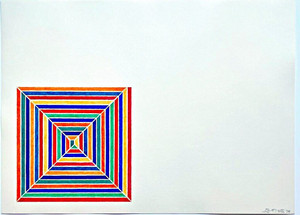
Frank Stella, Sharpesville, from Multicolored Squares I (Axsom 79), 1972
Frank StellaCONTACT GALLERY FOR PRICE
Frank Stella
Sharpesville, from Multicolored Squares I (Axsom 79), 1972
Lithograph on J. Green mould-made paper
Signed in graphite pencil, dated and numbered 31/100 (there were also 20 artist's proofs), bears printer blind stamp on the front
Frame included
Signed in graphite pencil, dated and numbered 31/100 (there were also 20 artist's proofs), bears printer blind stamp on the front
Lithograph on J. Green mould-made paper
Printed by Hammond and Kell Lithographers, London. Published by Petersburg Press, Ltd., London. From Multicolored Squares I. A very good impression of this scarce lithograph
Provenance: Dayton's Gallery, Minneapolis (with original label on the back of the frame) - a legendary gallery that first introduced Leo Castelli's stable of artists like Frank Stella, Robert Rauschenberg, Roy Lichtenstein, Jasper Johns and Andy Warhol to the midwest
Floated and framed in the original vintage metal frame with UV plexiglass
Measurements:
Framed:
18.25 inches vertical by 24 inches by 1 inch
Artwork:
16 inches vertical by 21.75 inches horizontal
This work features an intricacy of gradient greys and definitive edges, which contrast with the paper underneath. The geometric square sits in the lower-left corner of the page, contributing to the contrasts between color-coated, and bare paper. "Sharpesville" demonstrates the artist’s signature motif and technique; using a lithographic crayon to create the illusion that the works have been hand-sketched.
In 1970, Frank Stella became the youngest artist to be the subject of a major solo exhibition at the Museum of Modern Art, New York. In 2009, Stella was awarded the National Medal of Arts by President Obama.
According to Axsom, the Multicolored Squares I series is based on six paintings in the Concentric Squares and Mitered Mazes series of 1962-63. The titles Cato Manor and Sharpesville refer to racial disturbances in South Africa, as the sites of a riot and a massacre of sixty-nine black protestors in 1960 during the Apartheid era. Axsom 79.
While the catalogue raisonne calls this work "SHARPESVILLE", it is based upon Frank Stella's 1962 original painting called "SHARPEVILLE", and the name of the town in South Africa where the 1960 massacre was committed is also SHARPEVILLE.
Stella's original 1962 painting, upon which this print was based, sold in 2020 at Christies for $11.5 million USD. Below is an excerpt from Christie's catalogue notes on the sale of the original Sharpeville painting - the inspiration behind this lithograph, printed one decade later in 1972:
"One of only five large-scale 1962 paintings executed in shifting tones of black, white, and gray, Frank Stella’s Sharpeville marks an important juncture in the history of postwar art. Although an admirer of Abstract Expressionism, the artist—just 26 years old when he painted the present work—takes abstract painting in a different direction. The striking configuration of concentric squares draws the viewer into hypnotic rhythms, pulling one into the heart of the composition. Through this new form of artistic vocabulary, using commercial painters’ materials and the cool geometric palette, Stella breaks with the dramatic painterly gestures of some of his predecessors. William Rubin, the curator of the artist’s retrospective at the Museum of Modern Art in 1970, wrote in the catalogue for the exhibition, “At a time when abstract painting is frequently characterized by narrowness of its stylistic range, Stella’s… [art] reveals an extraordinary variety, not simply in the aesthetic structuring of the pictures but in their expressive character” (W. Rubin, Frank Stella, exh. cat., Museum of Modern Art, New York, 1970).
Sharpeville was painted in New York during this year of explosive creativity, which not only saw Stella produce his groundbreaking Concentric Squares and Mitered Mazes series, but the birth of Pop Art when Andy Warhol’s Campbell’s Soup Cans (Museum of Modern Art, New York) were first exhibited to great acclaim at the Ferus Gallery in Los Angeles. Sharpeville leads an important group of five large grayscale paintings in the series, three of which are in major international museum collections including Cato Manor, Senzon Museum of Modern Art, Tokyo; Les Indes Galantes (large version), Walker Art Center, Minneapolis; and Line Up, Hirshhorn Museum, Washington, D.C.
Although defiantly abstract, Stella’s paintings do contain references to temporal events. Here, the title references the Sharpeville massacre, a notorious incident that occurred in 1960 when white South African police officers opened fire on a large group of black protestors in the township of Sharpeville, killing 69 of them, including nearly two dozen children; the stark nature of the palette is reflective of the divisive atmosphere of apartheid South Africa. Interestingly, the title of another black-and-white painting from this series, Cato Manor, references another event in South Africa in which a group of protestors attacked and viciously killed a group of policemen in Cato Manor, a working-class suburb of Durban; many believed this event was partly responsible for the police opening fire so indiscriminately in Sharpeville."










